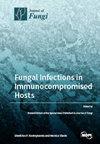新型隐球菌的嵌合 ORF 融合表型报告器
IF 4.2
2区 生物学
Q2 MICROBIOLOGY
引用次数: 0
摘要
后基因组时代产生的大量基因组序列并没有解决我们许多最迫切的生物学问题。将基因表达与可询问且易观察的特征(如报告基因赋予的替代表型)相关联,是深入了解基因功能的重要方法。包括 lacZ、amdS 以及荧光蛋白 mRuby3 和 mNeonGreen 在内的许多报告基因已被用于各种生物体中。本文描述的是一项研究,旨在为新生隐球菌创建一个强大的合成融合报告系统,该系统结合了该系统中一些最有用的荧光团和 amdS 的反选择性的多功能性。生成的报告基因包括多种组成和方向变体,所有这些变体的表达差异都进行了研究。对来自 TEF1 和 GAL7 基因的已知启动子进行了评估,阐明了这些与生物学相关的新生酵母菌转录调节因子的新表达倾向。融合 ORF 比 lacZ 小,但能提供多种有用的替代表型,与传统系统相比,融合 ORF 是一种出色的全细胞检测方法。最终,本文所描述的工作加强了相关遗传工具的阵列,这些工具可用于进一步操纵和了解世界卫生组织真菌优先类病原体C. neoformans。本文章由计算机程序翻译,如有差异,请以英文原文为准。
A Chimeric ORF Fusion Phenotypic Reporter for Cryptococcus neoformans
The plethora of genome sequences produced in the postgenomic age has not resolved many of our most pressing biological questions. Correlating gene expression with an interrogatable and easily observable characteristic such as the surrogate phenotype conferred by a reporter gene is a valuable approach to gaining insight into gene function. Many reporters including lacZ, amdS, and the fluorescent proteins mRuby3 and mNeonGreen have been used across all manners of organisms. Described here is an investigation into the creation of a robust, synthetic, fusion reporter system for Cryptococcus neoformans that combines some of the most useful fluorophores available in this system with the versatility of the counter-selectable nature of amdS. The reporters generated include multiple composition and orientation variants, all of which were investigated for differences in expression. Evaluation of known promoters from the TEF1 and GAL7 genes was undertaken, elucidating novel expression tendencies of these biologically relevant C. neoformans regulators of transcription. Smaller than lacZ but providing multiple useful surrogate phenotypes for interrogation, the fusion ORF serves as a superior whole-cell assay compared to traditional systems. Ultimately, the work described here bolsters the array of relevant genetic tools that may be employed in furthering manipulation and understanding of the WHO fungal priority group pathogen C. neoformans.
求助全文
通过发布文献求助,成功后即可免费获取论文全文。
去求助
来源期刊

Journal of Fungi
Medicine-Microbiology (medical)
CiteScore
6.70
自引率
14.90%
发文量
1151
审稿时长
11 weeks
期刊介绍:
Journal of Fungi (ISSN 2309-608X) is an international, peer-reviewed scientific open access journal that provides an advanced forum for studies related to pathogenic fungi, fungal biology, and all other aspects of fungal research. The journal publishes reviews, regular research papers, and communications in quarterly issues. Our aim is to encourage scientists to publish their experimental and theoretical results in as much detail as possible. Therefore, there is no restriction on paper length. Full experimental details must be provided so that the results can be reproduced.
 求助内容:
求助内容: 应助结果提醒方式:
应助结果提醒方式:


